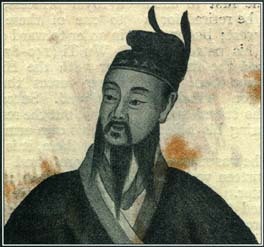Yellow Emperor
In Chinese mythology, Huang-Di (the Yellow Emperor) was the most ancient of five legendary Chinese emperors as well as a patron of Taoism, one of China's main religions and philosophies. He was also a culture hero, credited with civilizing the earth, teaching people many skills, and inventing numerous useful items, including the wheel, armor and weapons, ships, writing, the compass, and coined money.
According to tradition, the Yellow Emperor began ruling in 2697 B.C. His long reign was said to be a golden age, and he was honored as a benevolent and wise ruler. Before Huang-Di came to the throne, order and government were unknown in the world. He introduced systems of government and law to humankind, and he also invented music and the arts.
patron special guardian, protector, or supporter
culture hero mythical figure who gives people the tools of civilization, such as language and fire
benevolent desiring good for others
Legend says that the Yellow Emperor had four faces that gazed out in four directions, allowing him to see all that happened in the world. In addition, he could communicate directly with the gods through his prayers and sacrifices. When he traveled around his empire, he rode in an ivory chariot pulled by dragons and an elephant,

During Huang-Di's reign, only one god challenged his authority. The rebel god was aided by the emperor's son Fei Lian, lord of the wind. They sent fogs and rain to drown the imperial armies, but the emperor's daughter Ba (drought) dried up the rains and helped defeat the rebels.
imperial relating to an emperor or empire
immortal able to live forever
After ruling for many years, Huang-Di became tired and weak. He allowed officials to make decisions for him and went to live in a simple hut in the courtyard of his palace. Through fasting, prayer, and meditation, he discovered the tao, or way—a belief that leads to an ideal state of being. The Yellow Emperor continued to rule for many additional years, attempting to bring a state of perfection to his realm. Upon his death he rose into the heavens and became a Xian (or Hsien), an immortal .
See also Chinese Mythology ; Heroes ; Xian .
There are a few similarities between this Yellow Emperor character and the Son of God - Jesus Christ, who came from highest Heaven to earth , who had also created both the heavens and the earth and all things in them, at the begining of time and matter.
I suppose the story of the Yellow empoeror is called a myth because people cannot prove it scientifically.
There is a possibility that this 'Emperor' was a real person.
Taoism as a religion didn't appear till much later after this character is thought to have lived.
The web site - ancientchinalife -
shows that "Lao-tzu was the one who composed Taoism which talks of force in nature."
It also says that "In literary meaning Tao means Path."
According to this site the Yellow Emperor was a supporter of Taoism. An anomoly exists between the time of both these characters, which raises other questions.
Jesus Christ declared Himself to be 'THE Way (or path), the Truth and the Life" John 14:6
Lao Tzu is also a legendary character who existed around 6th century BC. according to 'famouspeople'another site. That is a long time after 2,600 BC , the time in which the Yellow Emperor is said to have existed.